12 Nutrition: Omnivores and Carnivores
Learning Objectives
- Define common terms and parameters in swine production
- Describe phase feeding in pigs
- Define feed budgets in pigs
- Describe rationale behind split-sex feeding in swine
- Describe required nutrients for feeding of swine, dogs, and cats
- Describe common feed ingredients used in swine feeds
- Explain economic impacts of food wastage in swine
- Compare natural feeding behaviors of dogs and cats
- Determine food dosage for the dog
- Describe body condition scoring in swine and dogs
- Describe feeding during gestation / lactation in sows, bitches, and queens
- Explain unique aspects of weaning, and feeding puppies and kittens post-weaning
- Discuss pros and cons of homemade and raw diets in dogs and cats, and vegetarian diets in cats
- Describe unique anatomy and physiology of the cat as an obligate carnivore
*
Swine and dogs are omnivores. Cats are true carnivores.
*
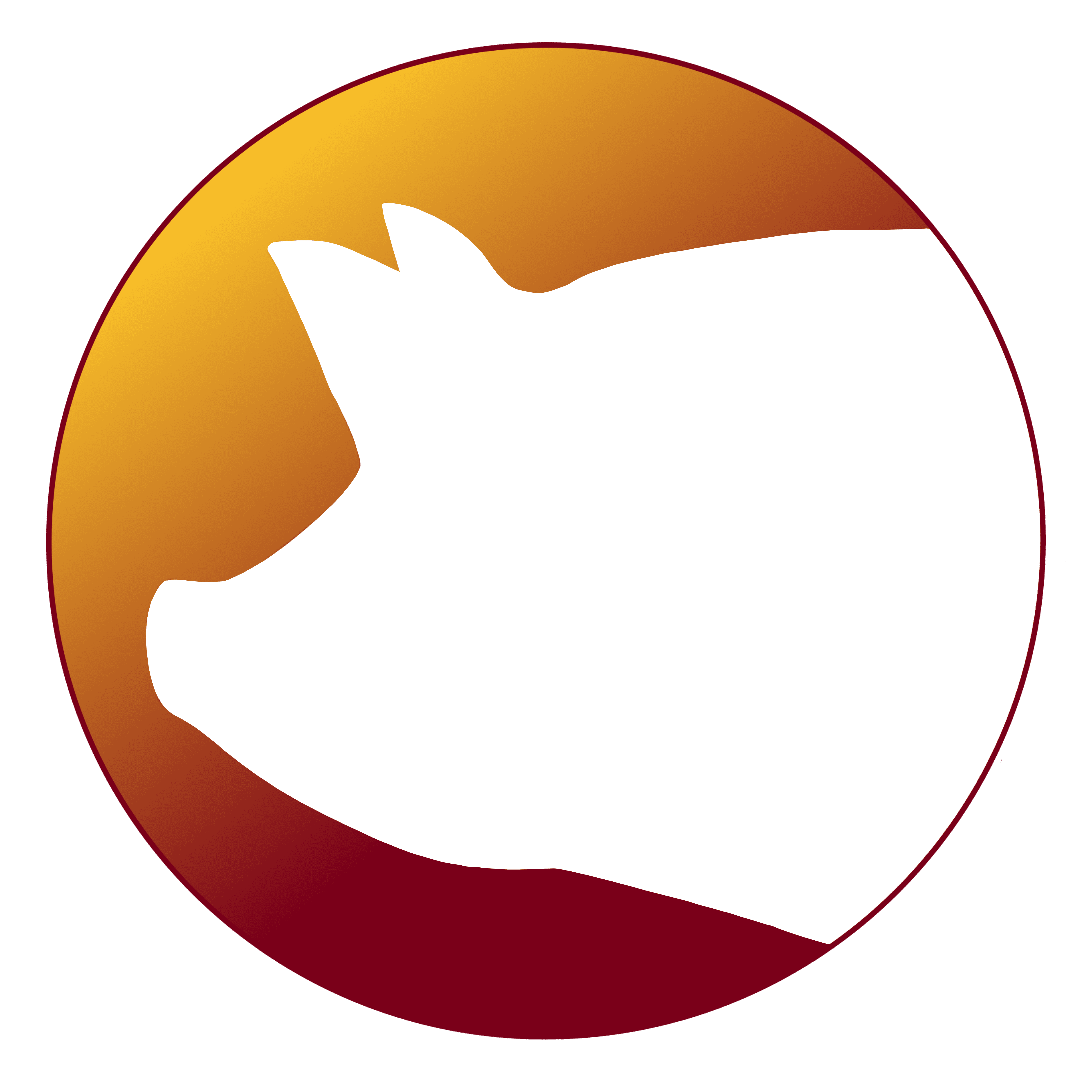 Feeding Swine
Feeding Swine
Pig Terminology Used In This Chapter
| Boar | Intact male pig |
| Barrow | Castrated male pig |
| Gilt | Young female pig not having produced her first litter |
| Sow | Older female pig having produced at least one litter |
| Pig | Younger swine (less than about 120 lbs) |
| Hog | Older swine (more than 120 lbs) |
| Weaner | Young pig (18-60 days of age) |
| Early-Weaned Pig | Pig weaned at less than 21 days of age |
| Litter | Multiple pigs born from same pregnancy |
| Gestation | 115 days of pregnancy |
| Lactation | 18-25 days after birth where sows nurse baby pigs |
| Grow-Finish | Production phase from 60-260 lbs body weight |
| Wean-to-Finish | Production phase from 10-260 lbs body weight |
| Nursery | Production phase from weaning to 60 lbs body weight |
| Feeder Pigs | 40-60 lb pigs sold for feeding to market weight |
| Market Hogs | Hogs weighing 240-280 lbs, ready for slaughter |
Production Phases of the Breeding Herd
Male Reproduction – Boar
Female Reproduction – Gilt development / pre-breeding to breeding to gestation to farrowing / lactation to weaning to rebreeding to gestation, etc.
Growing Pigs to Market – Nursing pigs (nursing off the sow, eating creep feed) with three phases (phase I 12-15 lb body weight, II 15-25, III 25-50) to grow-finish in four phases (phase I 5-100, II 10-150, III 150-200, IV 200-250) to market
Pork Production Measures for Growing Pigs
| ADFI | Average daily feed intake |
| ADG | Average daily gain = average amount of weight gained daily |
| F/G or G/F | Feed conversion = feed efficiency |
| % carcass lean | Ratio of lean:fat |
| Lbs lean gain/day | Lbs of lean body weight gained daily |
| Lean gain efficiency | Lbs feed per lbs lean body weight gained |
Pork Production Measures for Breeding Herd
| NPD = non-productive sow days | Time that sows are not pregnant or lactating – goal is fewer than 50 NPD/female/year |
| Litter size | Number of piglets in the litter |
| Litter weaning weights | Weights of piglets at weaning – this is a reflection of milking ability of the sow |
| Wean-estrus interval | Days from weaning to re-breeding – goal is 4-7 days |
| Farrowing rate | Percentage of females mated that farrow – goal is 85+% |
| Litters / sow / year | Goal is greater than 2.2 |
Phase Feeding
Pigs are commonly phase fed. This is a system of separating pigs by weight and feeding specific diets to those groups of pigs. The value of this is demonstrated in the graph below. The curved line shows daily lysine requirement. The stepped lines show either a 6-phase feeding program or a 2-phase feeding program. Note how pigs in these groups (or phases) are occasionally underfed and occasionally overfed as they grow. The goal of phase feeding is to minimize the amount of over- and underfeeding. There is increasing economic advantage in increasing number of phases (and therefore, number of group of pigs and number of diets provided) in pig production.
Phase Feeding Swine
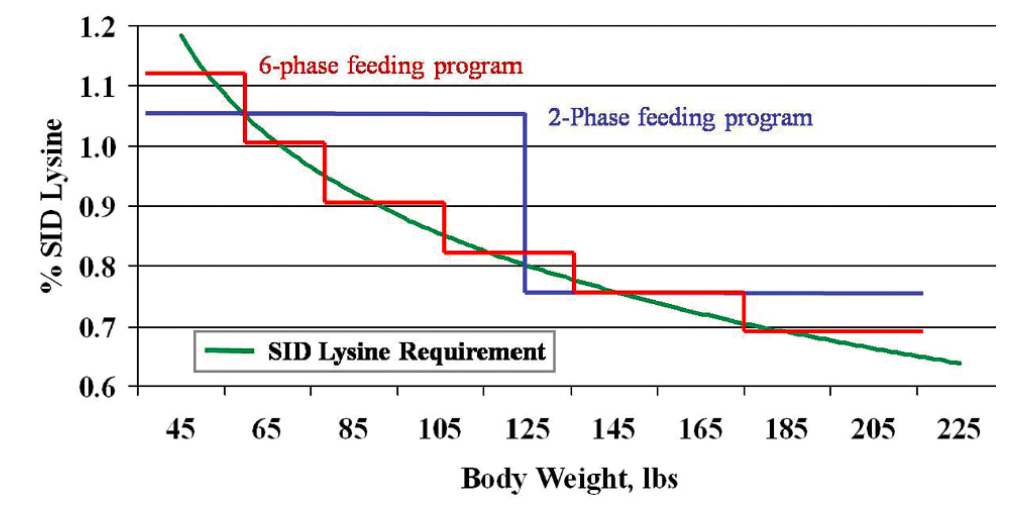

Feed Budgets
It is essential to get the right feed to the right pig for the right amount of time. An example is shown below, demonstrating how amount of food provided varies with phase (grower phases I-III and finisher I-III) and with body weight of those pigs.
Feed Budgets by Phase
| PHASE | G1 | G2 | G3 | F1 | F2 | F3 |
| BW (LBS) | 60-80 | 80-110 | 110-140 | 140-180 | 180-220 | 220-250 |
| AMT OF FEED (LBS) | 46 | 76 | 84 | 123 | 137 | 193 |
Split-Sex Feeding
Sometimes specific diets must be provided by sex. As an example, gilts have higher amino acid requirements and have a 5% greater lean growth potential than barrows. Gilts consume less than barrows so different diets must be provided for gilts and barrows when they reach about 80 lbs body weight. Another example is the change in diet required of sows as they go through their reproductive cycle. Assessment of body condition score (see image below) allows one to watch how sow weight varies and to feed to try to keep as consistent a body weight as possible. Generally, the sow is heavy until the time of farrowing and lactation, when she loses a lot of weight from giving birth and from milk production. It is difficult for sows to eat enough during lactation to gain weight and it is wise to keep a record of how much they eat (average daily feed intake) to plan for future pregnancies. Sows regain body condition after they wean piglets and generally are at a higher weight at the time of the next pregnancy, and then the cycle starts again.
Swine Body Condition Score Assessment
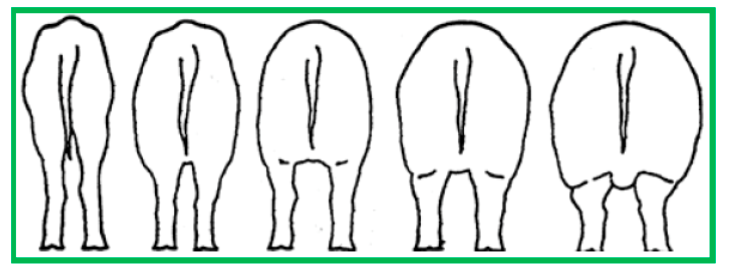
| SCORE | LAST RIB BACK FAT DEPTH | CONDITION | BODY SHAPE |
| 1 | <15 | Emaciated | Hips, spine prominent to the eye |
| 2 | 15-18 | Thin | Hips, spine easily felt without pressure |
| 3 | 18-20 | Ideal | Hips, spine felt only with firm pressure |
| 4 | 20-23 | Fat | Hips, spine cannot be felt |
| 5 | >23 | Overweight | Hips, spine heavily covered |
—”Swine nutrition guide”, https://prairieswine.com/rsc/swine-nutrition-guide-2/
Nutrition Goals
Nutrition goals in commercial pork production include the following: Maximizing net profit / pig space by minimizing cost of inputs (feed is 65% of the total cost of production; providing good nutrition to improve productivity, which reduces facility and labor costs/cwt* pork produced); supporting and maintaining high health; minimizing nutrient excretion and odor emissions; and ensuring pre-harvest food safety. * = hundredweight
Factors affecting feed cost/cwt pork produced are:
- Factors altering cost/ton of complete feed (cost of feed manufacturing and quality control, cost of service for commercial products, cost of feed delivery, profit margin of manufacturer)
- Factors affecting the rate of gain of body weight per lb of feed (diet digestibility, diet nutrient levels relative to requirements, feed wastage). Attention to proper nutrition and proper feeding of a correct diet supports pig health and economics for the producer.
Understanding Nutrient Requirements
Animals require amounts of nutrients per day, not % of nutrients in the diet. A key concept is that feed intake times nutrient concentration equals the amount of nutrient consumed per day. For example, let’s say a lactating sow is consuming 4.5 kg (which is 4500 gm) of feed per day and that the feed she is consuming contains 1.0% lysine. Her daily lysine requirement is 50 gm lysine/day. Is this diet adequate to meet her needs? Using the calculation above, feed intake (4500 gm/day) times nutrient concentration (0.01) yields a total consumption per day of 45 gm. This is deficient. This could be corrected by giving her more to eat of her current diet or by offering a diet that is higher in lysine.
Nutrient requirements vary with production phase due to genetics, gender, health, and housing conditions.
- Energy – Generally provided as starch (carbohydrates) and fat.
- Amino Acids – The ten essential amino acids (required in the diet) are lysine (first limiting), methionine (2nd limiting), threonine (3rd limiting), tryptophan (4th limiting), histidine, arginine, leucine, isoleucine, valine, and phenylalanine. “Limiting” refers to the composition in feed ingredients – lysine is the first amino acid to be inadequate in a corn-based diet, because there is limited lysine in corn.
- Macrominerals – Those supplemented are calcium, phosphorus, sodium, and chloride. Trace minerals supplemented are iron, copper, zinc, iodine, manganese, and selenium. Vitamins supplemented are the fat-soluble vitamins (A, D, E, K) and some water-soluble vitamins (riboflavin, niacin, pantothenic acid, choline, folic acid, biotin, B12).
- Water – Attention must be paid to water quality, quantity, and availability – Water is used for metabolism and to regulate body temperature, and it is a constituent of body tissues.
Feed Ingredients = Nutrient Sources
Most swine diets in the United States are comprised of corn (primary energy source), soybean meal (primary amino acid source), monocalcium phosphate (primary P source), limestone (primary Ca source), and a vitamin and trace mineral premix. Depending on cost and availability, other ingredients are partial substitutes for corn and soybean meal. Corn substitutes are barley, wheat, sorghum, and dried distillers grains with solubles (a mix of corn, rice and other grains that is a byproduct of distilling for brewing or creation of ethanol). Soybean meal substitutes are meat and bone meal, dried distillers grains with solubles, and synthetic amino acids. Nursery diets include lactose, dried whey, spray dried porcine plasma, fish meal, spray dried blood meal, and supranutritional levels of copper and zinc.
Feed Manufacturing
Grain is ground using a roller mill or hammermill – reduced particle size = increased nutrient digestibility. Average particle size should be 700-800 microns. Ingredients are mixed to ensure uniform dispersion in a complete feed. Most diets are fed in meal form. Nursery diets are fed in pellet or crumble form – these are complex diets with multiple ingredients.
Life-Cycle Feeding for Swine
Pigs are provided ad libitum access to feed (all they can eat, feed available continuously) in all phases except pre-breeding, breeding, and gestation. Sows are fed limited amounts (4-8 lbs/day) to control body weight gain and body condition.
Typical Ranges in Daily Feed Consumption Levels for Swine
| STAGE | AMOUNT (LBS/DAY) |
| Pre-Breeding | 4-8 |
| Breeding | 4-6 |
| Gestation | 4-6 |
| Lactation | 8-20 |
| Weaning-Rebreeding | 4-8 |
| Nursery Phase I (12-15 lbs BW) | 0 – 0.5 |
| Nursery Phase II (15-25 lbs BW) | 0.5-1.5 |
| Nursery Phase III (25-50 lbs BW) | 1.5-2.5 |
| Grow-Finish Phase I (50-100 lbs BW) | 2.5-3.5 |
| Grow-Finish Phase II (100-150 lbs BW) | 3.5-4.5 |
| Grow-Finish Phase III (150-200 lbs BW) | 4.5-5.5 |
| Grow-Finish Phase IV (200-250 lbs BW) | 5.5-.65 |
Feeder Design and Feeder Management
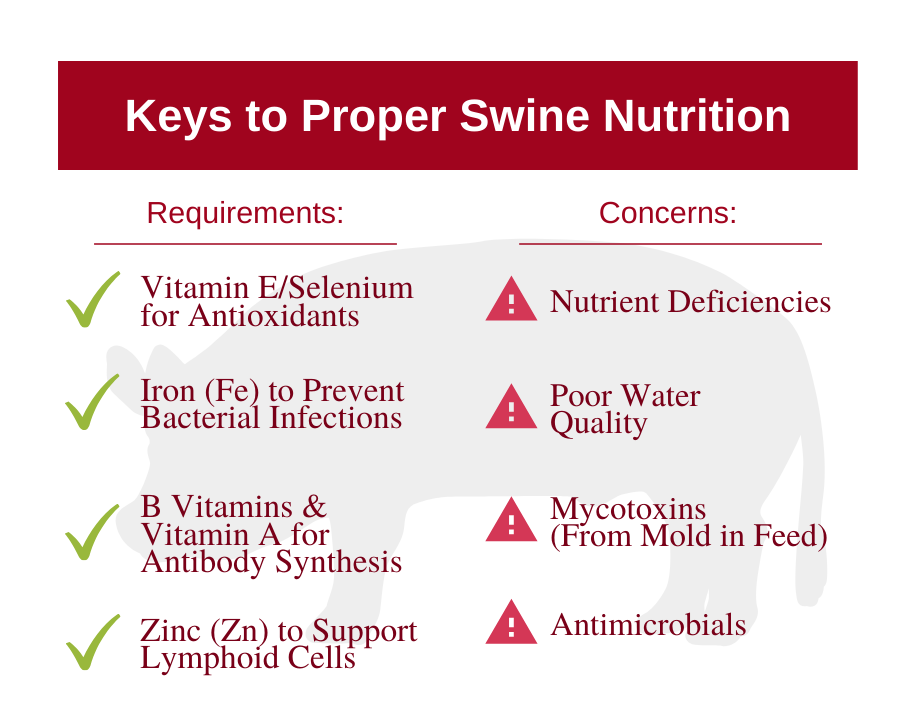
Feeder space and design is important to minimize chances of pigs fouling the feed with feces and to minimize feed wastage. Feed wastage can be as high as 20% due to inadequate design and/or management. In a study of grow-finish pigs, 5% feed wastage increased feed cost / pig by more than $2 and 20% wastage increased it by more than $8.
Nutrition and Health Conditions
Proper nutrition supports the immune system (Vit E / selenium are anti-oxidants, Vit A – antibody synthesis, Fe (too high or too low) – increased susceptibility to bacterial infections, Zn – role in lymphoid cells, B vitamins – deficiency reduces antibody synthesis). Concerns include nutrient deficiencies and toxicities – water quality – mycotoxins (toxins due to molds in feed = aflatoxin, doexynivalenol [DON], zearalenone, fumonisin), and antimicrobials (antibiotics, growth promoting levels of Cu and Zn).
*
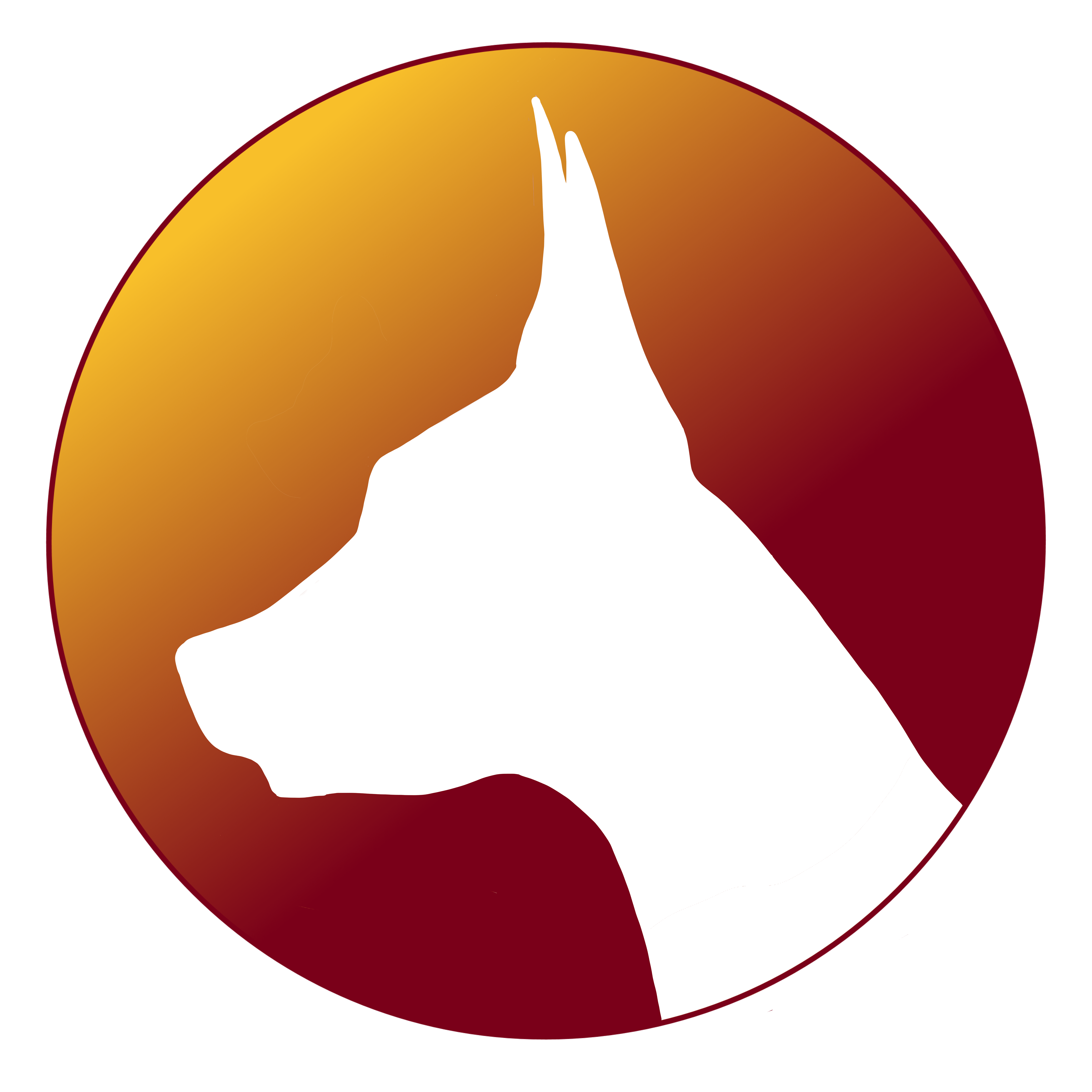 Dogs
Dogs
Feeding and Hunting
Dogs must be fed by life stage. Dietary goals include good quality of life, maximum longevity, optimization of performance, and disease prevention. For example, obesity is the number 1 nutritional disease in dogs and cats and is present in 12-40% of animals. It is associated with health risks (musculoskeletal disease, cardiovascular disease, cancer, diabetes mellitus, reduced immunocompetence), and with decreased life span. Other conditions associated with nutrition in dogs are dental disease and urolithiasis.
Wild dogs live in hierarchical groups. They hunt in packs and the dominant dog(s) eat first. They consume large meals (up to 16% of their body weight in a single meal). Dogs retain the “social value” of food. Their behavior is influenced by breeding, selection, and interaction with humans.
Nutrients
A nutrient is any food constituent that helps support life. Essential (also called indispensable) nutrients are those that the body cannot synthesize and that are needed at all life stages. Conditionally essential (conditionally indispensable) nutrients are those that are required only during certain physiologic or pathologic conditions. Nonessential (dispensable) nutrients are those that can be synthesized by the body.
Canine Feeding Behavior
Dogs are omnivores. They eat 1-3 meals/day and feed during daylight. They are glutton feeders (built to eat large volumes of food infrequently) and recognize the social value of food (food is a resource to guard).
Free Choice Feeding = ad libitum or ad lib
- Advantages: less labor and knowledge required, better share for non-dominant dogs
- Disadvantages: increased risk for obesity, skeletal disease, less knowledge about intake by each animal, for dry/semi-moist foods only
Food Restricted or Meal Feeding
- Advantages: best control and knowledge of intake, best control of body weight, reduced risk of obesity and skeletal disease, facilitates house training
- Disadvantages: labor-intensive, need to calculate food
Determination of food dosage is the basis for nutritional management and is a basic skill in nutritional therapy. We must calculate food dosage recognizing that dogs may be fed a complete and balanced diet, supplements, and treats.
Energy Requirements
Resting energy requirement (RER) is the energy used by an adult at rest in a thermoneutral environment. This level does not support activity, growth, or reproduction and is a function of metabolic body size. RER (kcal/day) = 70(BW in kg)0.75 or 30(BW in kg)+70 – use latter if body weight is between 2 and 46 kg. Canine maintenance energy requirement (MER) = 1-1.8 x RER and varies by intact status and life stage. These are averages; needs for specific individuals may be considerably higher or lower.
Canine Maintenance Energy Requirement
| TYPE OF DOG | MER (value x RER) |
| Intact adult | 1.8 |
| Neutered healthy adult | 1.6 |
| Adult prone to obesity | 1.4 |
| Geriatric animal | 1.4 |
| Adult needing to lose weight | 1.0 (note that this would be RER at ideal weight) |
Daily energy requirement (DER) is affected by breed, neuter status, age, activity, environment and so may be higher than MER – for example, daily energy requirement for dogs doing light work equals 2 x RER, for those doing moderate work equals 3 x RER, and for those doing heavy work equals 4-8 x RER. Animals that are late in pregnancy and are lactating have increased nutrient requirements. Animals that have been spayed or castrated have decreased energy requirements.

Food Dosage Determination
Calorie content is not required on pet food labels so to determine number of calories per cup, you may need to check the website or call the pet food company.
- Estimate RER as described as above
- Factor RER if necessary to get estimated maintenance energy requirement (MER) or daily energy requirement (DER)
- Select specific food, determine energy density
- Energy requirement divided by energy density = food dosage
Because individual animal needs vary, body condition scoring is important to determine if the amount of food calculated is ideal for a given animal. New ideal BCS = 4-5 on a 9-point scale – see chart below. This was defined by the Purina lifespan study – 48 Labrador retriever puppies were paired by weight and sex, with one member of the pair fed 25% less than the other. Dietary restriction resulted in lower prevalence and severity of osteoarthritis. The age when 50% of dogs were first treated for chronic conditions was 2.1 years later in restricted-fed dogs and the restricted-fed dogs had a 15% longer median lifespan and were considerably healthier than their free-fed littermates.
As an example of food dosage calculation and nutritional assessment, Ms. Gray owns a 5-year-old spayed female Beagle. The dog weighs 26 pounds and has a body condition score of 5/9. You collect a diet history and find that Ms. Gray is feeding 1.5 cups of food/day of a food that has 350 kcal/cup. No other food or treats are given. She wants to know if this is enough food. – First, calculate RER. Body weight is 26 pounds (11.8 kg). RER = 30(BW in kg)+70 = (30)(11.8)+70 = 424 kcal/day. She is a neutered healthy adult so her MER = 1.6 x RER = 678 kcal/day. She currently is eating 525 kcal/day (1.5 cups x 350 kcal/cup). Her body condition score is fine so this appears to be a good amount of food for her for right now. The owner should watch body condition and if the dog appears to be getting thin, she certainly could be getting more food, up to about 2 cups per day (678 / 350 = 1.9).
https://www.morrisanimalfoundation.org/sites/default/files/filesync/Purina-Body-Condition-System.pdf
Specific Versus All-Purpose Diets
Specific purpose diets are produced to feed dogs for specific life stages or specific activities. Examples include diets for growth, lactation, adults at maintenance, athletes / performance, and geriatric animals. Breed-specific diets exist. Veterinarians can prescribe diets to specifically treat disease, for example, highly digestible diets for intestinal disorders and diets with unique proteins for dogs that are allergic to common pet food ingredients.
Feeding Specific Types of Dogs
Gestation and Lactation
For the first 6 weeks of gestation, MER = 1.8 x RER and for the last 3 weeks of gestation, MER = 3 x RER. During lactation (the equivalent of heavy work), MER = 4-8 x RER with ad lib feeding. During lactation, carbohydrate is conditionally essential so the recommended diet has 20% of calories as carbohydrate. In the latter part of pregnancy, the bitch needs an increase in calories. She either can be fed more of her regular food or can be fed a growth or performance food.
Nursing Pups
Puppies that are nursing should gain 2-4 g/kg adult weight/day. Offer solid food (growth / lactation diet) at 3-4 weeks of age and wean off the dam at 6-7 weeks. Feed growing pups to have a slim figure (ideal BCS of 4-5) to promote normal hip development. Overconsumption of food after weaning (excess energy and calcium) is associated with development skeletal diseases such as hip dysplasia, osteochondrosis, panosteitis, angular limb defects, and other bone and cartilage dysplasias. Genetics and environmental factors also increase risk. Feeding recommendation for growth at < 4 months of age = 3 x RER, from 4-12 months of age = 2 x RER, and at greater than 12 months of age = 1.6 x RER. Feed the right diet (protein 25-35% DMB, calcium 0.9-1.5% DMB, energy 3.4-4.2 ME/g/DMB – feed the diet right – calculate starting point – evaluate every 2 weeks – adjust to maintain lean body condition.
Trends in Canine Nutrition
Home-Prepared Diets
Owners may wish to prepare diets at home because they equate nutrition with nurturing their pets, they want control over quality of ingredients (natural, preservative-free, color-free, organic), or to meet specific health goals for their pet. In 2020, survey data from over 3600 pet owners in the United States, Canada, Australia, New Zealand, and the United Kingdom described about 2/3 of dogs and 1/2 of cats receiving some homemade food at least some of the time, with more than half of dogs and at least half of cats sometimes getting raw diets. Owners should be aware that a recent review comparing cost of homemade diets to cost of commercial diets demonstrated that homemade diets were more expensive then dry commercial diets but less expensive then canned commercial diets. Another study demonstrated that if owners are going to create homemade diets, they are strongly encouraged to weigh ingredients instead of following volume measurements in recipes to ensure appropriate amounts of various foods are used to meet minimum amounts for cured protein, crude fat, and potassium in these diets.
Raw Diets
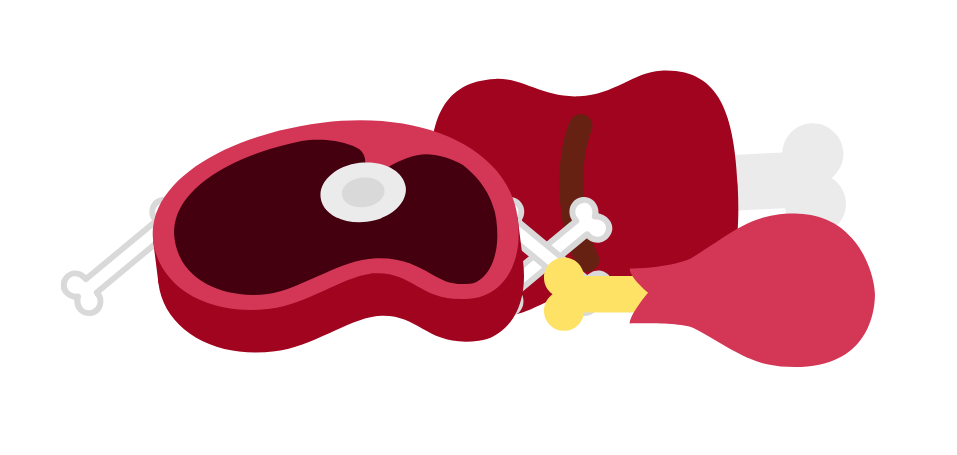
Three common names in the raw diet conversation for dogs are Billinghurst BARF, Schultz, and Volhard. All claim that no extra knowledge is required by owners to feed this diet. They all are based on raw meat, bones, and some vegetables and are intended not to be complete and balanced but to achieve nutritional balance over time. An increasing number of commercial raw preparations are available. Some are formulated to meet AAFCO nutrient profiles and may be complete and balanced in each meal. People may also prepare homemade raw diets. Raw diets may contain skeletal muscle meat from various species; organs; bones from mammals, fish, or poultry; unpasteurized milk; or uncooked eggs; and may contain grains and vegetables. They are usually very highly digestible, with high quality ingredients, and high water content that helps with satiety and weight control. Feeding of raw diets provides owners with a sense of nurturing. However, there are few high-quality studies and so there is no scientific evidence that raw diets provide superior nutrition. Studies have demonstrated that raw diets potentially have nutritional excesses or deficits, that use of vitamin A and D have the potential to be excessive if offal is used as an ingredient, and that calcium is a nutrient of concern especially in growing large breed puppies. Other concerns include the possibility of bones in the diet fracturing teeth and perforating intestines. Nutritional problems take years to manifest into clinical disease and people who choose to create a raw food diet or any homemade diet are encouraged to work with a veterinary nutritionist. Raw diets also pose safety concerns for the very young and very old (animals and humans) due to concerns about bacterial and parasitic contamination; studies suggest that 3-50% of adult dogs fed raw food diets may be asymptomatic shedders of Salmonella into the environment. In one study of dog owners feeding raw food diets, confirmed transmission of Salmonella from the pets to the people was 0.2%, with very young, very old, pregnant, and immunosuppressed people at greatest risk. Finally, it is valuable to help clients understand that some things they provide for their pets are uncooked and pose a risk of bacterial spread. This includes rawhides and pig ears provided as treats.
Grain-free diets
Grain-free diets contain a high proportion of peas, lentils, other legumes, and other ingredients including potatoes. The rationale is that dogs would not eat a significant amount of grain in the wild. In 2018, the FDA warned pet owners of a possible link between eating foods labeled as grain-free and development of a heart condition called dilated cardiomyopathy. Cause-and-effect of this association has not been defined.
*
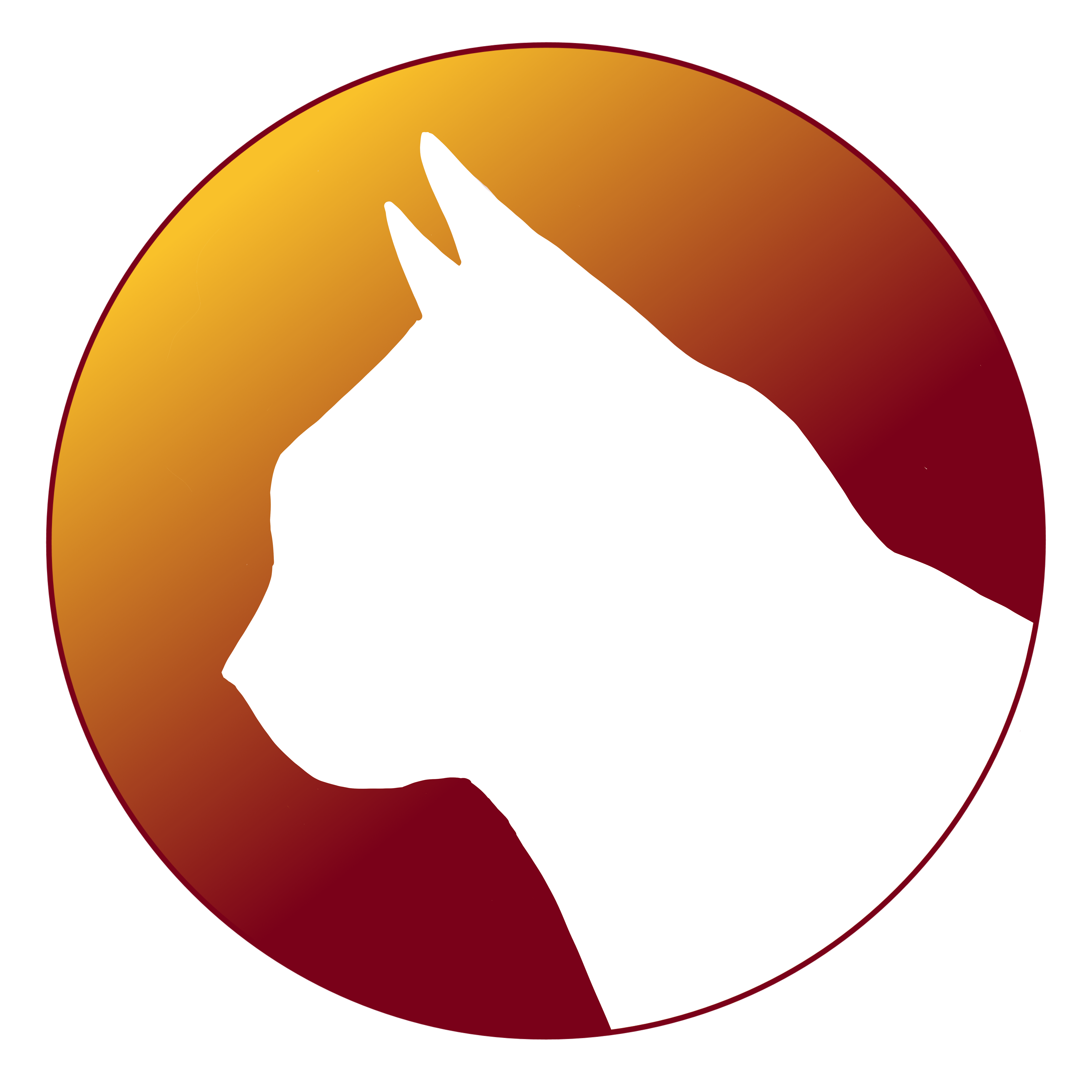 Cats
Cats
Feeding and Hunting Behavior
Cats are obligate carnivores. Their molars are vertically oriented and they have almost no lateral jaw motion. Their molars are not intended for grinding, as in omnivores and herbivores. They lack salivary amylase, and have a simple stomach and short intestinal tract.
Five traits of a cat are nocturnal (crepuscular), predators, territorial, solitary, and maternal.
Cats are exceptional hunters. In cats, hunting behavior is independent from feeding behavior, and they are solitary hunters and eaters, with no concept of the social value of food. Cats are constantly attuned to hunting, with hearing very acute when hunting at night and vision (motion) very acute when hunting during the day. Cats prefer to eat 10-20 small meals/day and in the wild, would spend 6-8 hours daily stalking prey. The average rat carcass provides about 5.7 kcal/gm of energy. How much cats eat is dependent on how much energy they get from it, not on the bulk of food eaten. Cats have specific preferences for temperature, odor, and physical form of food. Wild cats maintain body weight and fitness. House cats lose the ability to regulate energy intake due to readily available food and lack of physical activity. Best tips for cat owners are to feed smaller, more frequent meals throughout the day; provide food puzzles or other feeders that foster hunting behavior, feed individual cats separately in multi-cat households, and feed from an elevated location that is away from noise and visual threats.

Food Selection
Food selection is highly variable in dogs and cats and is based on senses (odor, temperature, mouth feel) and on past experience. Neophobia (disliking new things) is important in veterinary patients, who may choose not to try a new food. Milk composition is affected by maternal diet so pups and kittens may develop preferences at a very early age. Aversion to new foods is greater in cats than in dogs.
Nutrition and Energy Requirements
- Water – the most important nutrient. Age affects thirst, total body water, and water balance (intake versus loss). Domestic cat breeds are descendants of wild desert cats and so will concentrate urine significantly before they drink more water. They are not driven by thirst. In the wild they will get some water from their prey (1.5 – 2 mL / gm of prey eaten).
- Energy – In general, their daily energy requirement (DER) = 1.2 x RER
- Protein – Cats are missing some key enzymes and other enzymes are not adaptive (that is, they do not upregulate or downregulate relative to the presence of substrate). This contributes to their high protein requirement. For example, they require arginine to synthesize ornithine and citruline in the gastrointestinal tract as part of the urea cycle. A single meal devoid of arginine will lead to excess ammonia in the blood stream (hyperammonemia). Another example is taurine. Taurine is present in most animal tissues and can be synthesized from cysteine and methionine. Cats lack the enzymes necessary to consistently synthesize taurine and lose it through the gastrointestinal tract as it binds bile acids. In general, cats require protein as 19% of the diet – food animal tissue should be listed within the first two ingredients on a dry food and within the first three ingredients for a canned food.
Feeding adult cats – Atkins-type diet for cats = high protein and fat, low carbohydrate – The natural feline diet is 7% carbohydrate (DMB) so this kind of diet is well suited for cats.
- Lipids – Consume up to about 65% of the diet without negative effects. Cats require linoleic acid (like dogs) but also require arachidonic acid.
- Low Carbohydrates – Cats lack sucrose taste buds, their small intestine has low sucrase and lactase activity, they have non-adaptive sugar transporters that do not upregulate with a high carbohydrate diet, they lack salivary amylase, and their pancreatic amylase concentration is only 5% that of dogs. Carbohydrates can be up to 30% of the diet.
- Vitamins and Minerals– Cats have some unique vitamin requirements – Key vitamins required in high amounts or preformed are vitamins A and D, and niacin. Vitamin K may be required in the diet during long-term antibiotic therapy. Mineral requirements are similar to that in dogs. Calcium and phosphorus deficiency is the most common deficiency reported, especially in those cats who are on all meat diets. The sodium requirement in cats is three times that in dogs.

Feeding Specific Types of Cats
Gestation and Early Lactation
Queens have an increased requirement for energy, protein, fat, calcium and phosphorus, soluble carbohydrates, taurine and copper. Unlike in bitches, who need a change in diet to one with increased energy at mid-gestation, queens should gain weight gradually throughout pregnancy and so should be changed to a growth / lactation diet as soon as it is known that they are pregnant. At the end of lactation, when kittens are weaning, the queen should have a gradual reduction in energy provided as follows: the day prior = little / no food, weaning day ¼ DER, next day ½ DER, next day ¾ DER, 3rd day full DER.
Kittens
See chart below as a reference. Kittens should gain 50-100 g/wk. Feed a growth/lactation diet beginning at 3 weeks of age, wean kittens at 8-10 weeks of age, and then free choice or meal feed three times daily.
Key Nutritional Factors in Finding the Ideal Kitten Diet
| Energy | 4.0-5.0 Kcal/g |
| Protein | 35-50% DM |
| Fat | 18-35% DM |
| Carbohydrate | 10% DM |
| Crude Fiber | <5% DM |
| Calcium | 0.8-1.6% DM |
| Ca:P ratio | (1.1-1.5):1 |
| Potassium | 0.6-1.2% DM |
| Magnesium | 0.08-0.15% DM |
Neutered Adult Cats
Cats that have been spayed or castrated have decreased RER associated with a 25% reduction in DER, increased food intake, and decreased insulin sensitivity. Because cats naturally eat many small meals, it can be difficult to decrease calories and maintain body condition without exercising cats. Options for ways to increase exercise in cats can be found through the Indoor Pet Initiative and Purrfect Fence.
Current Trends
Raw Diets
Concerns are as in the dog. Feeding “human grade” tuna is a concern because that tuna is high in polyunsaturated fatty acids and is associated with vitamin E deficiency, steatitis (fatty inflammation), vitamin K antagonism, loss of B vitamins when the fish is cooked, excess in minerals (for example magnesium), and possible fixation on specific foods.
Vegetarian Diets
In cats, feeding of vegetarian diets is associated with inadequate protein / amino acids (taurine, arginine) and arachidonic acid, and alterations in other nutrients (vitamin A, B12, niacin, calcium, iron, zinc, copper).
Homemade Diets
Feeding of homemade diets may be associated with problems especially if they contain all meat or very high protein, deficient calcium, excess phosphorus, excesses of vitamins A and D toxic to the liver, and deficient microminerals. Thiamin may be deficient in raw fish diets. Homemade diets can be made safely and be complete and balanced but involve cost and effort. Consultation with a veterinary nutritionist is recommended.

*
https://www.in.gov/boah/files/Cat-BCS-from-Purina.pdf
 Extra Resources
Extra Resources
- Ways to increase indoor exercise in cats: https://indoorpet.osu.edu/home
- To keep cats safe during outdoor exercise: https://www.purrfectfence.com/



